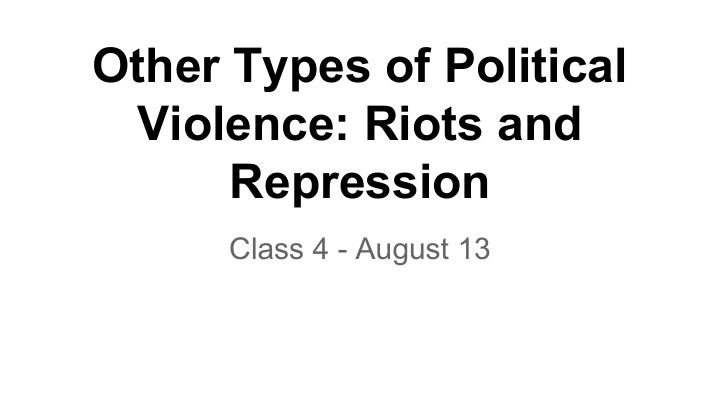



Other Types of Political Violence: Riots and Repression Class 4 - August 13
Review: Definition of a political riot ● “intense, sudden, but not entirely unplanned attack by a group of civilians against members of another distinguishable group” ● Goals vary based on riot, depend on organization ● Often have ethnic/religious overtones.
Process of riot inception ● Underlying intergroup tension. ● Triggering event ● News travels to affected group ● Group members form gangs and attack group perpetrator of trigger. ○ People are killed based on their ascription or beliefs.
Riot Characteristics ● Aggressors enter state of frenzy and target out-group for killing. ● Killing is often grotesque and symbolic. ● Victims chosen based on group affinity. ● Arson used to displace people, businesses. ● Opportunists use riot as cover for looting.
Recent Examples of Political Riots China - Xinjiang (Uyghurs target Han Chinese) Kyrgyzstan - Osh (Kyrgyz target Uzbeks Nigeria - widespread, many ethnic groups India - Assam, Uttar Pradesh (Muslims vs. Hindus)
Causes of Political Riots ● Brass: Organized by politicians for nation- building ● Horowitz: Ad hoc, underlying tensions. ● Wilkinson: Electoral manipulation ● Others: Land disputes, refugee flows, prior violence.
Brass: Riots are planned and deliberate ● Underlying conditions for political riots must be present. ● Individuals in society: ‘tenders’ fan the flame of violence to exploit outcomes for own gains. ○ Mobilize gangs, etc. ● Ex: Riots organized by BJP to galvanize Hindu nationalists and win elections.
Horowitz: Ad hoc organization ● Ethnic tensions are necessary for violence. ● Tensions prerequisite to situation where small spark will set off fighting. ● Rumors of violence or other triggers foment anger among the targeted group. ● Targeted group briefly congregates, leaders emerge, begin attacks.
Horowitz: Lull between trigger and riot ● A short break between triggering event and riot allows for some organization. ● Ad hoc, loose organization is beneficial. ● Plans are improvised.
Wilkinson: Electoral Manipulation
Wilkinson: Electoral Manipulation ● In India, politicians initiate riots for electoral purposes. ○ Create wedge issues between low-caste Hindus and Muslims. ● Highlights politically-organized processions through each other’s neighborhoods. ○ Leads to back and forth.
Wilkinson: Results ● How does Wilkinson test hypothesis? ● What are the measures of political inflammation? ● Are these measures convincing?
Other explanations ● Struggle for land ● Demographic shifts/parity ● Refugee resentment ● Violence begets violence
‘Miss’ World Riots in Nigeria Riot Case
Background ● Nigeria is a multi- ethnic society. ● North is mostly Muslim, south is mostly Christian ● Kaduna state is majority Muslim ● Riots in Kaduna state in 2000.
What happened? ● Trigger: Newspaper article ● Protests -> attacks by Muslims -> retaliation by Christians. ● Political leaders made threatening statements before riots.
Discussion ● What leads to riots? What role do politicians play? Are underlying causes economic or ethnic or both? ● What is the best explanation for ‘Miss World Riots’?
Review: Definition of repression ● Physical sanctions against opponents of regime to deter further anti-government activities (paraphrasing Goldstein). ● Involves jailing, extrajudicial killing, preventing organization, etc. ● Goal: Prevent opposition to the government.
Selectorate Theory: Governments don’t need to make you happy Residents Citizens Selectorate Winning Coalition
Types of Government ● Absolute Monarchy ○ Small Selectorate, small winning coalition. ● Rigged Autocracy: ○ Large Selectorate, small winning coalition. ● Democracy: ○ Large Selectorate, Large Winning Coalition
Government are accountable based on coalition size, composition ● Small Winning Coalition: Private goods to supporters, cleptocracy, low accountability to citizens. ● Large Winning Coalition: Public goods to supporters, low corruption, high accountability to citizens.
Governments prefer not to repress and to stay in power. ● Which do they prefer more?
Reasons for Repression ● Dissent from anti-government opposition ● Past successes in repression. ● Non-Democracy. ○ Why?
Davenport: Domestic Democratic Peace ● Democracies repress less due to two features: ○ Voice ○ Veto ● Voice > Veto ● Democracy reduces repression during conflict.
What’s missing?
What’s missing? Autocracies vary in repressive behavior too: Indifferent leaders can get overthrown.
Repression also varies in autocracies ● Autocracies don’t always want to repress. ○ Would increase risk of overthrow. ● Some create democracy-lite institutions (Gandhi 2007). ● Pay off some opposition, oppress the rest (Lust-Okar 2006). ● Resource rich autocrats would rather pay off opponents (Dunning 2008).
Repression in Azerbaijan Repression Case
Background ● Former Soviet state ● Oil rich ● Ruled by Aliyev family. ● Some civil society and democratic competition. ● No free elections.
Methods of suppressing opposition
Methods of suppressing opposition ● Imprisonment and harassment
Methods of suppressing opposition ● Imprisonment and harassment ● Media suppression
Methods of suppressing opposition ● Imprisonment and harassment ● Media suppression ● NGO suppression
Methods of suppressing opposition ● Imprisonment and harassment ● Media suppression ● NGO suppression ● Restrictions on protest and assembly.
What explains variation in repression across countries? What explains repression in Azerbaijan in particular?
Recommend
More recommend